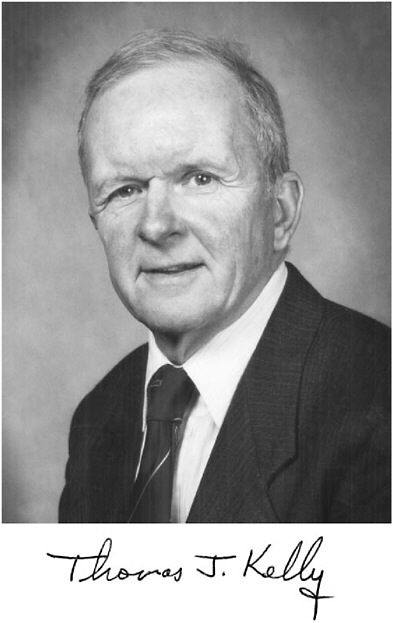THOMAS J. KELLY
1929–2002
Elected in 1991
“For leadership in designing, developing, and supervising the construction of the Apollo Lunar Module.”
BY J.G. GAVIN JR. WITH CONTRIBUTIONS BY JOAN KELLY
WHEN THE PRESS REPORTED the death of Thomas J. Kelly on March 23, 2002, the nation learned that it had lost a true space pioneer. Kelly played a major role in validating the advantages of lunar orbit rendezvous as the preferred strategy for sending humans to the Moon. He was instrumental in the development of Grumman’s proposal that resulted in the selection of Grumman Aerospace to design and build the Lunar Module for Apollo. As chief engineer, manager of spacecraft assembly and testing, and engineering manager, he was the engineering leader in the development of the Lunar Module, and, based on his accomplishments, he earned the unofficial title, “Father of the Lunar Module.”
The Lunar Module was successful in every mission and was the “lifeboat” for the aborted Apollo 13 mission. This was the result of an extraordinary team effort, and Thomas J. Kelly deserves a great deal of the credit for forming, leading, and motivating the engineering team. Considering the unknowns at the beginning of the Apollo Program, his team’s accomplishments provide a classic example of inspired systems design. At the time, one of the founders of Grumman commented, “I hope you young fellows understand what you have committed the company to do!”
Kelly was not only a competent, practical engineer, but also a visionary. He worked well with people on a demanding schedule and in a tense environment; the Lunar Module Program was
initiated less than a year after the Command and Service Module Program began. People liked to work with or for Kelly. He “told it like it was” and refused to be discouraged by setbacks.
Thomas J. Kelly spent most of his professional career which began right after he graduated from Cornell, at Grumman. Kelly was born June 14, 1929, in Brooklyn, New York, spent his formative years on Long Island, and his undergraduate education was supported by a Grumman scholarship. A number of early assignments at Grumman prepared him for his later responsibilities. He designed the air inlets for the first Grumman aircraft to exceed twice the speed of sound. He was a prime mover in the well regarded but unsuccessful proposal for Project Mercury. He was a key player in a Grumman team that supported General Electric’s unsuccessful bid for the Apollo Command and Service Module contract.
As mentioned earlier, Kelly led the Grumman-funded study that validated the Lunar Orbit Rendezvous strategy for going to the Moon. John Houbolt of the National Aeronautics and Space Administration (NASA) had argued that this approach was clearly more efficient than the Earth Orbit Rendezvous plan. An intense debate in NASA ensued, and Kelly’s briefing based on Grumman’s study was a major contributor to the acceptance of the Lunar Orbit Rendezvous plan.
The competition for the Lunar Module contract was unique. Instead of the usual proposed design, NASA asked bidders to answer 20 questions to show their understanding of the design challenge. Kelly led the group that assembled Grumman’s winning response. In the early days of the Grumman effort, it became apparent that NASA, North American (later Rockwell), and Grumman needed a common, standard mission on which to base design efforts. Kelly proposed a joint undertaking, which led to the formation of the Apollo Mission Planning Task Force to work on this vital problem.
During Apollo Missions 9, 10, 11, and 12, Kelly led the Grumman support team at Mission Control at the Manned Space Flight Center in Houston. Grumman then sent Kelly to the Sloan School of Management at the Massachusetts Institute of Technology, but he returned to Houston without finishing his assign-
ment to join the Grumman support team coping with the aftermath of the explosion in the Apollo Service Module during the Apollo 13 mission. The Lunar Module became a cold but successful “lifeboat,” and the astronauts were saved. In the post-Apollo, post-Sloan days, Kelly made a major contribution to Grumman’s bid for the Space Shuttle contract.
Kelly was appointed to the Board of Directors of the New York State Science and Technology Foundation by Governor Hugh Carey in 1979. The organization helped state businesses and universities with useful encouragement for notable start up projects, and Tom served on the board until he retired.
He was elected to the National Academy of Engineering in 1991. He received the NASA Certificate of Appreciation, 1969, and the NASA Distinguished Public Service Medal, 1973. In 1972 he was awarded the AIAA Spacecraft Design Award and the Cornell Engineering Award.
He was a member of the following societies: American Astronautical Society (AAS); American Institute of Aeronautics (AIAA) (Board of Directors member 1974–1980); American Society of Mechanical Engineers (ASME); Cornell Society of Engineers; and Columbia Engineering Council.
Tom Kelly was a multi-talented musician. He had a wonderful baritone singing voice and sang with the Huntington Choral Society and then with the North Fork Chorale when the family moved to Cutchogue.
Even though he never really gained weight as he became older Tom decided he needed something else to keep him healthy. That was running. He was usually up at 5:30 a.m. to run before work, and he felt it cleared his head and made him feel good. He ran, when he was home, away, or even on vacation and enjoyed every minute of it. It was precious time for him.
Tom Kelly is survived by his wife and life partner, Joan Tantum Kelly, and two generations of younger Kellys. His sons are David, Thomas Jr., Edward, Christopher, and Peter and his daughter, Jennifer, the only one who has pursued a career in engineering so far. His 11 grandchildren are Shannon, Rachel, Kevin, Christopher, Cuchulain, Finn, Cormac, Oonagh, Savanna (all Kellys), and Ryan and Katchen Lachmayr.





